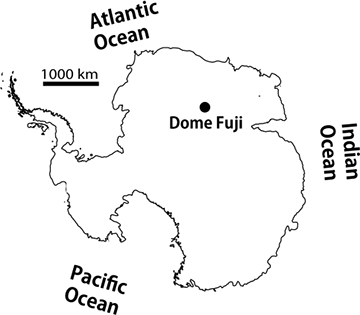National Institute of Polar Research
[Research Highlight] Layered densification of the Antarctic firn explained
Released on May 24, 2016 (in Japanese)
Posted on December 12, 2016
National Institute of Polar Research
The layered densification of Antarctic firn is explained as a result of the complex effects of two independent phenomena: (i) 3D geometrical structure of the firn influenced by the metamorphism conditions on the ice sheet surface and (ii) impurity-induced softness of the ice matrix within firn. Information about the metamorphism conditions is preserved in the softness of firn throughout the densification process, as it is only weakly disturbed by the secondary effects of impurity-based softening.
"Firn" is an intermediate state between snow and ice. Understanding the evolution of firn in polar ice sheets is fundamental to interpreting signals of climate change recorded in polar ice cores. Metamorphism and initial layering of snow are known to be dependent on various surface conditions, such as the accumulation rate, temperature, and temperature gradient. After the initial processes of firn formation at the surface of the ice sheet, firn subsequently undergoes various processes of deformation with both increasing time and depth. Such processes are complex. On one hand, it has been suggested that metamorphism that occurs at the surface of the ice sheets is correlated to the orbital changes of local summer insolation; the summer insolation modifies the texture of firn by influencing ice-ice bonding, clustering of ice crystal, and the anisotropic geometry of ice and pore spaces. These factors are hypothesized to control the densification rate of firn. On the other hand, impurity ions have also been suggested to be a major contributor controlling the densification rate of firn. Oxygen in water molecules in the ice lattice can be substituted by some ions such as chloride, fluoride, or ammonium. Such substitution can modify softness of the ice matrix within firn. A key question then is, how is impurity-induced softening related to the insolation-induced densification rate?
To answer this question, scientists investigated firn cores from a major deep ice coring site, Dome Fuji, on the plateau of East Antarctica, using firn data such as density, anisotropic geometry, and chemical ion impurity. They found that layered densification is explained as a result of complex effects of the two independent phenomena. First, layers with initially lower density and smaller geometrical anisotropy deform preferentially throughout the densification process due to insolation-induced textural effects. Second, layers having a higher concentration of chloride ions deform preferentially during a limited period in near-surface depths until smoothing of layered chloride ions by diffusion. They also observed that this preferential deformation of chloride-rich layers appeared only in the uppermost 30 meters of the entire 100-meter thickness of firn, and that it did not erase the initial density-layering from the insolation-induced textural effects. Scientists therefore suggest that the information of the local radiation balance is preserved in deep ice core signals, as it is only weakly disturbed by the secondary effects of impurity-based softening. The results of the research are published in the Journal of Glaciology (Fujita et al. 2016, doi:10.1017/jog.2016.16).
Dr. Shuji Fujita of the National Institute of Polar Research, Tokyo, is the lead author on the paper and has commented: “Our work contributes to understanding why some properties of gas trapped in deep polar ice cores are correlated with local summer insolation. Indeed, gas trapping process into ice in firn is influenced by the local radiation balance. This understanding is very important for dating ice cores, because local summer insolation in Antarctica can be calculated over long periods astronomically. In addition, based on variations of some properties of gas extracted from ice cores, we can compare the variations the properties of gas with calculated variations of the local summer insolation. Then, we can determine date of ice cores accurately.”
Published Paper
Journal: Journal of Glaciology, 62(231), pp. 103-123
Title: Densification of layered firn in the ice sheet at Dome Fuji, Antarctica
Authors: Shuji FUJITA1,2, Kumiko GOTO-AZUMA1,2, Motohiro HIRABAYASHI1, Akira HORI3, Yoshinori IIZUKA4, Yuko MOTIZUKI5, Hideaki MOTOYAMA1,2, Kazuya TAKAHASHI5
1: National Institute of Polar Research, Research Organization of Information and Systems, Japan
2: Department of Polar Science, the Graduate University for Advanced Studies, Japan
3: Kitami Institute of Technology, Japan
4: Institute of Low Temperature Science, Hokkaido University, Japan
5: RIKEN Nishina Center, Japan
DOI: 10.1017/jog.2016.16
URL: https://doi.org/10.1017/jog.2016.16
Acknowledgement
This study was supported by The Japan Society for the Promotion of Science KAKENHI (20201007, 20241007)
Contact
Public Relations Section, National Institute of Polar Research
E-mail: kofositu@nipr.ac.jp

Figure 1: Location of Dome Fuji where the ice cores were obtained in East Antarctica

Figure 2: Left: Image showing ice coring in progress in the inland plateau of Antarctica. The instrument indicated by the arrow is an ice coring drill. The site is surrounded by vehicles and wind shelters. Right: Ice core soon after extraction. Cores appear white because the mixture of ice and pore spaces scatters the surrounding light.








